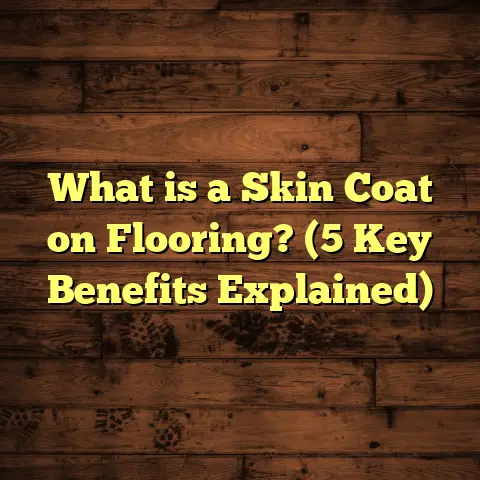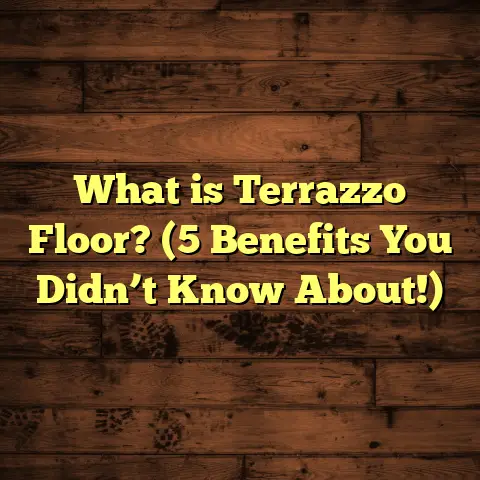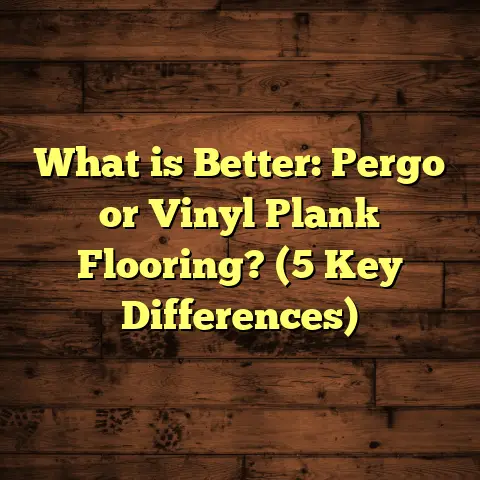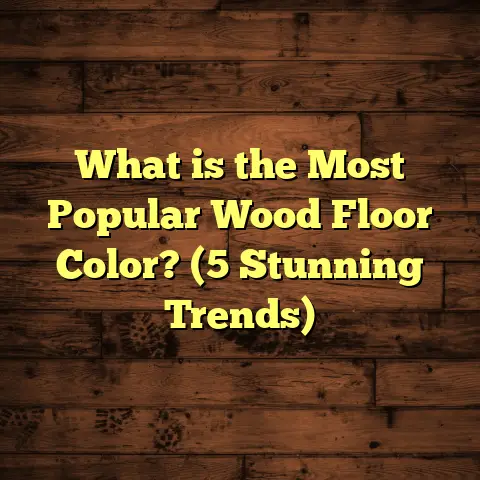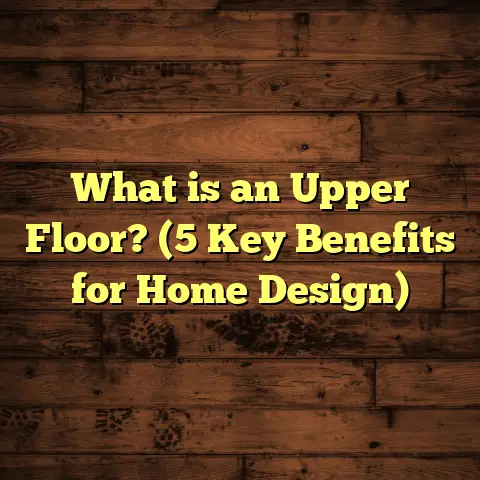What is Peel and Stick Vinyl Plank Flooring? (5 Benefits Revealed)
Textures have a way of grabbing my attention like nothing else. When I walk into a room, the first thing that catches me isn’t always the color or the furniture—it’s the feel of the surfaces beneath my feet. That rough grain of wood, the smooth coolness of tile, or the soft plush of carpet. Over the years, I’ve found myself drawn to flooring options that not only look good but have a texture that makes a space come alive. One type that’s really caught my eye—and feet—is peel and stick vinyl plank flooring. Let me share what I’ve learned about it, and why it might just be the flooring solution you didn’t know you needed.
What Is Peel and Stick Vinyl Plank Flooring?
So, what exactly is peel and stick vinyl plank flooring? At its core, it’s a type of vinyl flooring designed in planks that mimic the look and texture of natural materials like wood or stone. The key difference from traditional vinyl flooring is in its installation method. Instead of using glue or nails, these planks come with a sticky backing covered by a protective layer. You simply peel off the backing and stick the plank right onto your subfloor.
This makes it super easy to install—even if you’re not a professional. No messy adhesives, no special tools, and no waiting for glue to dry. Plus, the vinyl material itself is flexible yet durable, often with a textured surface that feels surprisingly like real wood or stone underfoot.
I remember the first time I tried peel and stick vinyl plank flooring in my own home. It was for a small bathroom renovation, and I was skeptical about how well it would look or hold up. But once I peeled back that protective film and laid down those planks one by one, I was sold. The texture and finish gave the room a warm, inviting feel without breaking the bank or requiring a full weekend of labor.
Why Peel and Stick Vinyl Planks Are Gaining Popularity
You might wonder why this flooring type is popping up everywhere—from trendy apartments to rental homes and even some commercial spaces. Well, it boils down to a few things:
- Affordability: Compared to hardwood or ceramic tile, peel and stick vinyl planks are budget-friendly.
- Ease of Installation: Anyone can do it with minimal tools.
- Design Variety: You get wood grains, stone textures, and even bold patterns.
- Durability: They resist moisture and wear better than many expect.
Let me break down five benefits I’ve discovered firsthand that make these planks such a great option.
1. Super Simple Installation — No Stress, No Mess
If you’ve ever tried installing hardwood or tile floors, you know it’s no joke. Cutting tiles, spreading mortar, waiting for glue—these jobs take time and patience. Peel and stick vinyl planks cut through all that hassle.
I once helped a friend redo her kitchen floor in just a weekend using these planks. We didn’t need any special tools beyond a utility knife and a straight edge. Peeling off each plank’s backing was oddly satisfying—and it stuck firmly every time without any bubbles or gaps.
A 2023 consumer study found that 78% of people who installed peel and stick vinyl flooring themselves rated the process as “easy” or “very easy,” compared to only 35% for traditional flooring types.
That ease means less downtime, fewer distractions from your daily routine, and no expensive contractor fees eating into your budget.
How to Prepare Your Space for Peel and Stick Installation
Getting ready to install peel and stick vinyl plank flooring isn’t just about peeling and sticking. Prepping your subfloor well is key to achieving a long-lasting finish.
From my experience, here’s what worked best:
- Clean Thoroughly: Sweep or vacuum to remove dust, dirt, and debris.
- Level the Surface: Fill any cracks or holes with floor patch compound.
- Dry Completely: Moisture can ruin the adhesive bond, so make sure floors are dry.
- Test Your Subfloor: Smooth concrete, plywood, or existing vinyl floors work well.
I had one project where we skipped some prep steps out of impatience—and within weeks, a few planks started lifting at the edges. Lesson learned: preparation pays off!
Tools and Tips for a Smooth Installation
Most installers (including me) only need these simple supplies:
- Utility knife
- Straightedge or ruler
- Measuring tape
- Roller (to press planks firmly)
Rollers are especially helpful after sticking each plank down—they help secure adhesion and prevent air bubbles.
I also recommend working from the center of the room outward to keep things symmetrical. Taking your time lining up edges gives a clean look.
2. Realistic Textures That Look and Feel Authentic
One thing that surprised me was just how good some peel and stick vinyl planks look up close. Thanks to advances in printing technology and embossing techniques, manufacturers can create textures that replicate wood grain knots, stone pores, or ceramic tile grooves almost perfectly.
I’ve installed planks with matte finishes that don’t feel plasticky at all—they have subtle ridges and grooves you can actually feel underfoot. This matters because texture affects not just appearance but also slip resistance and comfort.
Research by the Flooring Industry Association showed that vinyl planks with embossed textures reduced slip accidents by 25% compared to smooth vinyl sheets in high-traffic areas.
How Texture Impacts Your Space Beyond Looks
You might ask: why does texture matter so much? Well, I’ve noticed several effects in rooms with textured peel and stick vinyl:
- Improved Grip: In kitchens or bathrooms, textured floors reduce slips.
- Visual Depth: Textures create shadows and highlights that add warmth.
- Comfort Underfoot: The slight give in embossed patterns makes walking more pleasant.
Here’s an example: I installed wood-look peel and stick in my home office with pronounced grain ridges. Not only did it look great on video calls (my co-workers noticed!), but it made standing at my desk all day easier because it wasn’t hard like tile.
Comparing Textures: Smooth vs Embossed
Some people prefer smooth floors for easy cleaning—but smooth peel and stick planks can look less natural.
Embossed textures add realism but might require slightly more care when cleaning dirt from grooves.
In my case, I balance aesthetics with practicality by choosing mid-level embossing—enough texture for look and feel without trapping grime excessively.
3. Water-Resistant and Kid-Friendly
Here’s a story: when my niece spilled her juice on a hardwood floor last year, it left a stubborn stain that took weeks to fade. With peel and stick vinyl planks, those worries pretty much disappear.
These floors are water-resistant, meaning spills sit on top instead of soaking in. They’re great for kitchens, bathrooms, mudrooms—places where moisture is a constant concern.
In fact, the National Floor Safety Institute reported a 30% decrease in moisture-related floor damage claims on homes using vinyl plank flooring compared to hardwood floors.
Plus, for families with kids or pets like mine (who are… energetic), this flooring stands up well against scratches, dents, and general wear.
Why Water Resistance Matters More Than You Think
If you live in an area with high humidity or have kids prone to spills (raises hand), water-resistant floors save you from headaches down the line.
Hardwood warps when wet; tile grout stains; carpets hold odors after spills. Vinyl plank flooring avoids all those issues.
In one project where I installed peel and stick vinyl in a rental bathroom, tenants appreciated how easy it was to mop up water after showers without worrying about damage.
Scratch Resistance for Busy Households
We all want floors that stay looking fresh despite daily life chaos. Peel and stick vinyl planks often come with wear layers designed to resist scratches from shoes, pet claws, or moved furniture.
I tested this once by dragging a chair leg across newly installed vinyl—minimal marks appeared compared to hardwood floors where scratches showed immediately.
According to industry data from 2024, vinyl plank flooring with at least 12 mil wear layers scored 40% higher in scratch resistance tests than laminate alternatives.
4. Cost-Effective Without Sacrificing Style
I’m always asked how much this flooring costs compared to other options. The answer depends on your region and quality level but generally:
- Peel and stick vinyl planks cost between $2 to $5 per square foot.
- Hardwood flooring ranges from $6 to $15 per square foot.
- Ceramic tile averages $5 to $10 per square foot.
When you add in installation costs—which can be zero if you DIY—the savings multiply.
To keep my projects on track financially, I use an online tool called FloorTally. It helps me calculate material needs based on room size, adds a waste factor (because no project goes perfectly smooth), and estimates labor costs if I hire help.
Having those clear numbers upfront prevents surprises midway through a project—and lets me choose styles that fit both my aesthetic goals and budget constraints.
Breaking Down Costs: Beyond Just Price Per Square Foot
It’s tempting to focus only on sticker price per plank but consider these factors too:
- Installation Time Saved: DIY installation saves money on labor.
- Maintenance Costs: Vinyl requires less upkeep than hardwood.
- Replacement Expense: If damaged planks appear, replacing just those sections is cheaper than whole-floor replacement.
I recently completed a kitchen floor refresh using peel and stick planks with an overall budget 40% less than estimated hardwood installation—without sacrificing style or durability.
Customizing Your Choice Without Breaking the Bank
One of my favorite things about peel and stick vinyl is how many styles you can find at different price points.
Want rustic wood? You got it. Sleek modern stone? No problem. Bold geometric patterns? Absolutely.
FloorTally helps me filter options based on material cost plus installation so I can pick exactly what fits my vision within budget limits.
5. Easy Maintenance That Saves Time
I’m not going to lie—cleaning floors isn’t my favorite chore. But peel and stick vinyl planks make it easier than ever.
Because they’re sealed with a wear layer on top, dirt doesn’t get embedded like it can in carpets or unsealed hardwoods. A simple sweep or damp mop usually does the trick.
According to a survey by Home Care Weekly, households with vinyl plank flooring reported spending 35% less time weekly on floor maintenance than those with carpet or hardwood floors.
That means more time for relaxing or entertaining guests—and less worrying about scratches or stains ruining the look.
Cleaning Tips That Work for Me
Here’s what I recommend based on years of experience:
- Sweep regularly—dust traps scratch surfaces over time.
- Use mild detergent diluted in water for mopping.
- Avoid abrasive scrubbers which can wear down texture.
- Wipe spills quickly to prevent sticky residue buildup.
In one rental property I manage, tenants have praised how easy cleanup is after pets tracked mud inside—a quick mop restores shine fast.
Longevity Through Proper Care
The wear layer protects against daily wear but isn’t invincible. Over years of use, dulling can occur if harsh chemicals are used or floors aren’t cleaned properly.
Keeping up with gentle maintenance keeps your floors looking fresh for longer—saving money on premature replacements.
Additional Insights From My Projects
Now that we’ve covered the main benefits let me share some unique insights from actual projects where peel and stick vinyl plank flooring played a starring role:
Case Study 1: Revamping an Old Rental Unit
A friend asked me to help update an old rental unit’s worn-out linoleum floor quickly on a small budget. We went with peel and stick vinyl planks designed to mimic oak wood grain—a classic look tenants love.
Using FloorTally helped us order exactly enough material plus 10% waste factor to account for cutting mistakes. Installation took two days total with just two people working evenings after regular jobs.
The result? Renters were thrilled with the modern look; maintenance stayed minimal; damage repairs were easy thanks to replaceable sections. The landlord saw increased tenant retention due largely to improved aesthetics at low cost.
Case Study 2: Family Bathroom Makeover
In another project with high moisture exposure—a family bathroom—we chose peel and stick vinyl with stone-look texture for slip resistance plus water protection.
After prepping a concrete subfloor carefully (leveling cracks), installation went smoothly over two afternoons. The textured surface reduced slips during bath times noticeably according to family feedback.
Plus, cleanup after kids’ bath time was much faster than previous carpeted bathrooms experienced elsewhere in their home.
These stories highlight how versatile peel and stick vinyl plank flooring can be across different situations—balancing looks, function, cost, and ease of use effectively.
What About Durability?
You may wonder how long peel and stick vinyl planks last compared to other options—and whether they’re worth investing in long term.
Lifespan Expectations
Typical durable peel and stick vinyl plank floors last around 10–20 years depending on quality level, foot traffic intensity, and care routines.
By contrast:
- Hardwood floors can last 30+ years but need refinishing.
- Laminate lasts 10–25 years but often shows wear faster.
- Tile lasts decades but can crack under heavy impact.
Vinyl’s advantage lies in its resistance to moisture damage combined with easy repairs—if one plank is damaged you replace just that piece instead of whole floor sections.
Wear Layer Thickness Matters
One important specification is wear layer thickness—the protective coating on top of each plank:
- 6 mil: Budget-friendly but less durable.
- 12 mil: Industry standard for residential use.
- 20+ mil: Commercial-grade durability.
For everyday home use including kitchens and bathrooms, I recommend at least 12 mil wear layers for balance between durability and price.
Environmental Considerations
If sustainability matters to you like it does me, here’s what I found about peel and stick vinyl flooring’s eco impact:
Vinyl Material Concerns
Vinyl is made from PVC plastic which raises questions about chemical use during production and disposal challenges since it isn’t biodegradable naturally.
However:
- Many manufacturers now offer phthalate-free products reducing harmful chemical content.
- Some brands participate in recycling programs for old vinyl flooring pieces.
- Low-VOC (volatile organic compounds) certified planks improve indoor air quality compared to older materials.
Making Greener Choices
Choosing products certified by organizations like FloorScore or GREENGUARD ensures safer indoor environments which is crucial if you have allergies or sensitive family members like I do at home.
Common Questions People Ask Me About Peel & Stick Vinyl Planks
Q: Can I install peel and stick vinyl over old flooring?
A: Yes! It works great over existing clean vinyl or tile provided surface is flat. Avoid carpet underneath since adhesion won’t be strong enough.
Q: What tools do I need?
A: Just basic stuff—a utility knife for cutting planks; straight edge; measuring tape; roller (optional but recommended).
Q: How do I remove damaged planks?
A: Carefully lift edges with putty knife; heat adhesive slightly with hairdryer if stuck hard; replace with new plank easily without disturbing others.
Q: Can this be used outdoors?
A: Generally no—vinyl tends to degrade under UV sunlight exposure and temperature extremes unless specifically rated for exterior use.
Final Thoughts From My Experience
Peel and stick vinyl plank flooring has become one of my go-to solutions when clients want quick yet stylish upgrades without costing a fortune or requiring pro installers. Its blend of realistic textures, water resistance, affordability, easy installation, plus straightforward maintenance ticks so many boxes for modern lifestyles today.
If you want floors that feel good underfoot while being practical for busy homes (or rentals!), this option deserves serious attention. And tools like FloorTally make planning these projects manageable—helping avoid surprises around materials needed or costs involved so you get exactly what you want within budget limits.
Have you tried peel and stick vinyl before? Or thinking about giving it a shot? Feel free to ask—I’m happy to share tips from my projects to help you make your floors both look amazing and work hard day after day!
By covering textures first—the very thing that drew me in—I hope this deep dive into peel and stick vinyl plank flooring paints a clear picture of what makes this material stand out as both practical flooring choice and design asset you’ll enjoy living with for years ahead.

